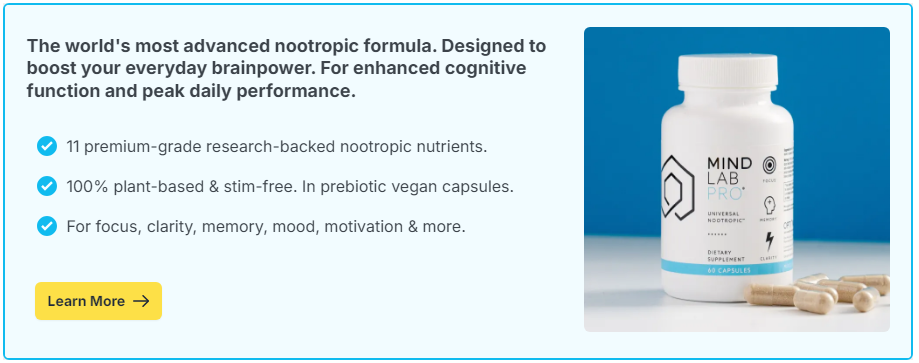
You’ve probably heard it in conversation, maybe even described yourself this way: “I’m more of a left-brained person—logical and analytical,” or “I’m definitely right-brained—creative and intuitive.”
It’s a tidy explanation for personality, learning styles, and even career choices. There’s just one problem: it’s not how the brain actually works.
The idea that people are either “left-brained” or “right-brained” is one of the most persistent neuroscience myths in pop culture. It oversimplifies the way our brains process information—and sells short the incredible interconnectivity that makes cognition possible.
Here we look at where this myth came from, what modern science says about brain lateralization, and how a more accurate understanding of your brain can improve your focus, creativity, and cognitive performance.
Contents
- Where the Left-Brain/Right-Brain Idea Came From
- What the Brain Actually Values: Integration, Not Isolation
- Common Misconceptions (and the Real Deal)
- How This Affects Learning, Work, and Focus
- Training Your Brain for Balance
- Can Nootropics Help Facilitate Whole-Brain Function?
- Let Go of the Labels—Build the Skills
Where the Left-Brain/Right-Brain Idea Came From
The myth has roots in real science—but it grew into something much bigger (and less accurate) than originally intended.
In the 1960s, neuroscientists Roger Sperry and Michael Gazzaniga conducted split-brain experiments on patients who had undergone surgery to sever the corpus callosum (the bundle of fibers connecting the brain’s hemispheres) to treat severe epilepsy.
These studies revealed that certain functions are more dominant in one hemisphere than the other:
- The left hemisphere was more involved in language processing and sequential reasoning
- The right hemisphere was more involved in spatial awareness, facial recognition, and holistic pattern recognition
From these observations, pop psychology took a leap: people who are “left-brained” must be logical, while “right-brained” people must be creative. The myth was born.
But Here’s What the Science Actually Shows
While hemispheric specialization is real, it’s far more nuanced than the left/right dichotomy suggests. Nearly all complex tasks—writing, problem-solving, art, speech—require both hemispheres to work together through constant communication.
In healthy brains, the two halves are never in isolation. The left may handle syntax, but the right picks up on emotional tone. The left helps with math operations, while the right visualizes shapes and spatial relationships.
So if you’ve been told you’re “not good at math because you’re right-brained” or “not creative because you’re left-brained”—it’s time to toss that label out the window.
What the Brain Actually Values: Integration, Not Isolation
Your brain isn’t split into “logic” and “emotion” departments. It’s an integrated system that works best when multiple regions collaborate across hemispheres. This integration allows you to:
- Understand not just what someone says, but how they mean it
- Solve problems that require both analysis and intuition
- Create ideas that are both beautiful and functional
The most effective thinkers, creators, and communicators use whole-brain processing—weaving together the best of both hemispheres rather than favoring one.
Common Misconceptions (and the Real Deal)
Myth #1: Logic lives only in the left brain
While the left hemisphere often handles language-based reasoning, logic also requires pattern recognition, emotional regulation, and working memory—processes that involve both sides of the brain.
Myth #2: Creativity lives only in the right brain
Creativity draws on emotion and imagination (right hemisphere), but also on sequencing, language, and structured planning (left hemisphere). A great novel, for example, requires both.
Myth #3: People are either left- or right-brain dominant
Modern brain imaging has debunked this. A 2013 study from the University of Utah scanned over 1,000 brains and found no evidence of consistent “dominance.” Functional tasks recruit regions from both hemispheres depending on context.
How This Affects Learning, Work, and Focus
Buying into the left/right brain myth can box you in:
- If you think you’re “not creative,” you may avoid exploration, imagination, or emotional expression
- If you think you’re “not logical,” you may underestimate your ability to analyze or plan
But your brain is designed to grow in both directions. Neural plasticity means you can train yourself to improve pattern recognition, decision-making, visual thinking, emotional regulation, and creative ideation—regardless of your natural leanings.
Whole-Brain Thinking In Action
Consider an architect:
- They use the right hemisphere to imagine a building’s aesthetics, light flow, and atmosphere
- They use the left hemisphere to draft structural equations and floorplans
It’s not one side or the other—it’s the symphony of both that brings vision to reality.
Training Your Brain for Balance
Want to become more well-rounded in your thinking? Try exercises that encourage hemisphere collaboration:
- Mind mapping: Mix visuals and logic to explore ideas
- Creative writing with structure: Combine narrative flow with grammar rules
- Music practice: Reading sheet music blends rhythm, math, and intuition
- Visual note-taking: Use symbols, diagrams, and color to reinforce analytical content
These activities promote neural cross-talk and enhance your brain’s ability to switch modes fluidly—a key skill in today’s complex world.
Can Nootropics Help Facilitate Whole-Brain Function?
Some people use nootropic supplements to support neural communication and mental agility. Certain ingredients—like citicoline and phosphatidylserine—support the formation of acetylcholine, a neurotransmitter crucial for learning and focus. Others, like L-theanine and Rhodiola, help regulate stress, keeping emotional and logical centers in sync. While supplements can’t rewire your hemispheres, they can enhance mental clarity and balance during tasks that require multidimensional thinking.
Let Go of the Labels—Build the Skills
Stop asking whether you’re more left-brained or right-brained. Ask instead:
- How well do I use both sides of my brain?
- Where could I grow my capacity for creativity and structure?
- What habits, tools, or support systems help me access deeper thinking?
The most powerful brains aren’t biased toward one side. They’re flexible, adaptive, and integrated.
The left-brain/right-brain myth is convenient—but inaccurate. Your brain is much more sophisticated than that. It doesn’t fit neatly into categories. It blends. It collaborates. It adapts.
And that’s good news. Because it means you don’t have to be “logical” or “creative.” You can be both—if you give your brain the space, structure, and support to grow in every direction.
In the end, real genius doesn’t live in one hemisphere. It lives in the connections between them.

